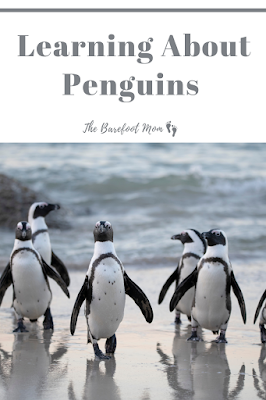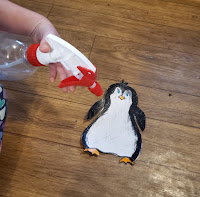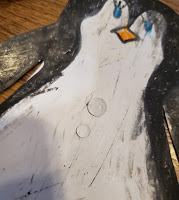Penguins are undoubtedly one of the most unique and specialized groups of birds. They're also incredibly cute, so of course we had to include them in our bird study! This post includes some information about penguins to share with your kids, links to videos and other online resources, and a free printable penguin activity!
Information About Penguins
Penguins are flightless sea birds that mainly live in Antarctica, though there are a few species that live further north in warmer climates. Penguins have many adaptations that allow them to survive in such cold, harsh environments. They have a thick layer of blubber and thick skin to help keep them warm in the cold Antarctic winters. Their bodies also can control the amount of blood flow to their feet, so they can reduce blood flow in cold weather, thus reducing the amount of heat lost to the cold icy ground.
Penguins eat fish, krill, and squid and are highly adapted for hunting in the water. Unlike other birds, penguins wings are designed for swimming instead of flight. They are stiff and shaped similarly to the flippers of sea mammals. Penguins also have webbed feet for steering in the water. Some penguin species can swim at speeds up to 22 miles per hour!
Penguins vary in size. The smallest species, the "little penguin" is about 13 inches tall and weighs just over 3 pounds. The largest species, the emperor penguin, stands about 4 feet tall and weighs around 50 pounds.
Penguins lay 1-3 eggs per clutch, depending on species and the individual. Some lay their eggs in burrow nests dug into the ground. Other species build rock nests. Emperor and king penguins don't build nests at all, instead males incubate the eggs on their feet, tucked under a pouch of skin and feathers.
How Do Penguins Stay Dry Activity
Some species of penguins spend up to several months at a time living in the frigid waters around Antarctica. To help keep them warm and dry, penguins have a gland that secretes a waxy oil that spreads over their feathers. This waxy coating repels water and helps keep penguins dry, even while swimming. Here's a simple activity to demonstrate how this works:
For this activity you will need:
-A penguin coloring sheet- you can grab one here
-Black, white, and yellow crayons
-Scissors
-A spray bottle filled with water
Print or sketch yourself a penguin and color the entire thing with crayons. It's important that the whole penguin is colored, even the white portions. Try to apply the crayon as thickly as possible.
Cut your penguin out. Then try spraying a small amount of water onto your penguin with the spray bottle. You should see the water bead up instead of soaking into the paper. This happens because the waxy crayon repels water, just like the waxy coating on real penguin feathers!
Additional Resources About Penguins
-Fun Facts About Penguins from Cool Australia
-Penguin News from Penguins International
-All About Penguins for Kids: Penguins of the World video from FreeSchool
-Emperor Penguins-The Greatest Wildlife Show on Earth video from BBC Earth
-Fishing with Emperor Penguins video from National Geographic
And don't forget to grab a free "How Penguins Stay Warm and Dry" printable activity here: https://www.teacherspayteachers.com/Product/How-Penguins-Stay-Warm-and-Dry-Activity-7600962
If you enjoyed this post, check out the rest of the posts in my Learning About Birds series and my All About Birds printable unit study.
Follow me on








This looks like a fun winter study!
ReplyDelete